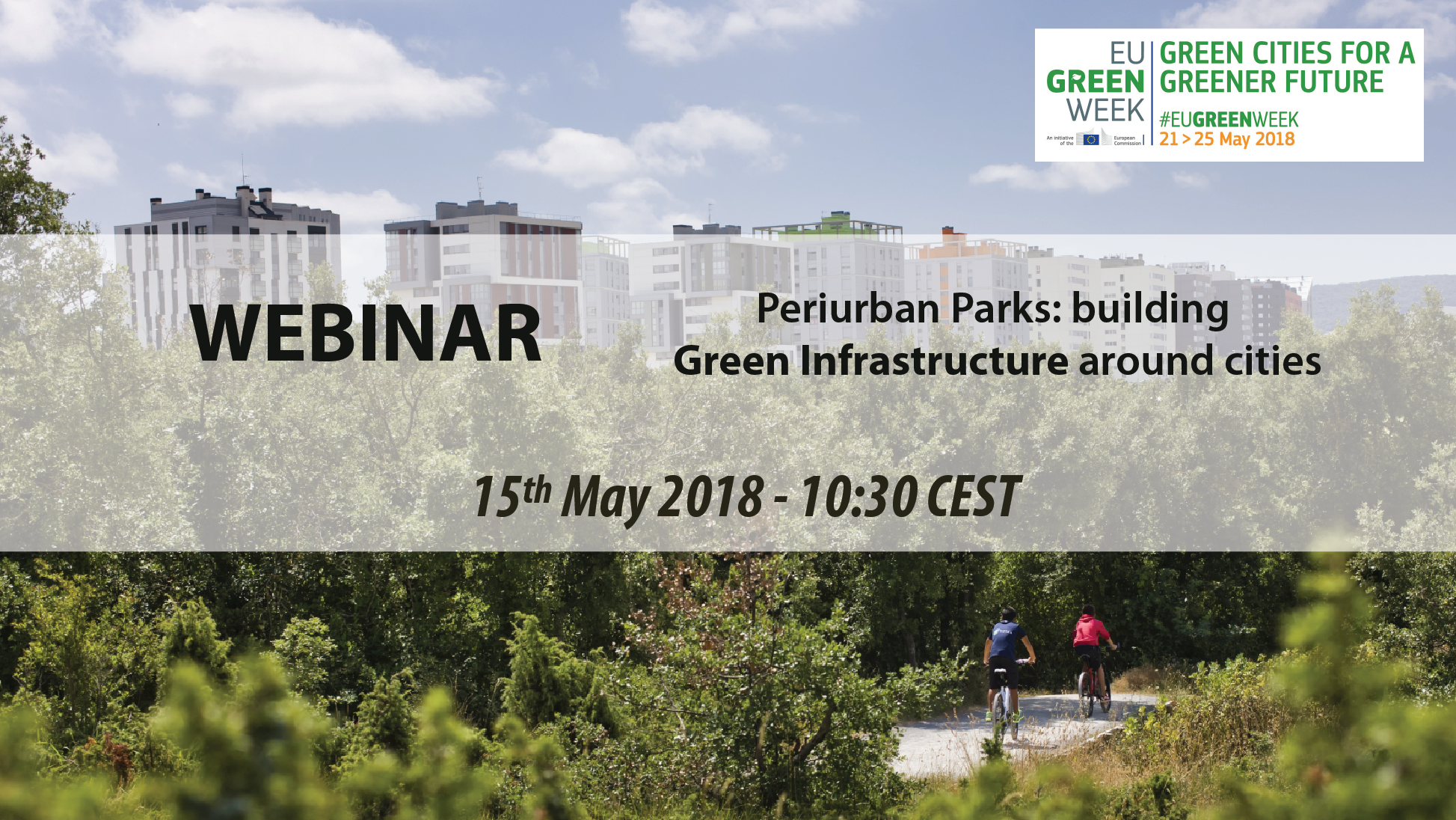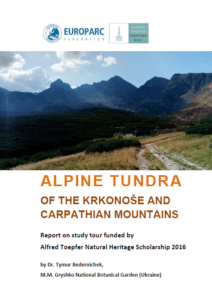EUROPARC Conference 2018: Registrations are now open!
The EUROPARC Conference 2018 is the key event of the year for those working in Europe’s Protected Areas and from 18-21 September the EUROPARC Conference will take place at the Macdonald Aviemore Resort in the stunning Cairngorms National Park.
‘European Parks: Inspired by the Next Generation’
18-21 September, Cairngorms National Park, Scotland
The theme for 2018 is ‘European Parks: Inspired by the Next Generation’ and hundreds of delegates from across Europe are expected to attend and focus on what National Parks and protected areas can learn from young people.
EUROPARC 2018 will call for young people to be more involved in decision making, volunteering, working and living in Parks.
A key part of connecting with the millennial generation will be the launch of a collaborative Youth Manifesto, which National Parks from across Europe will have the opportunity to sign up to. The conference supports the Scottish Year of Young People 2018 and aims to inspire and motivate delegates from across Europe to increase young people’s participation and engagement in nature and the outdoors.
Bring along a young person!
It is important that we bridge the generation gap and have that discussion alongside the youth of Europe, therefore, we are proud to invite you to bring a young person to the Conference! There will be a special conference youth rate (for youngsters up to 30) and a workshop is included for them. Lead the change with us!
EUROPARC Conference 2018: Programme overview
The conference will be hosted by Muriel Gray, with three inspiring keynote speakers who are not to be missed. Richard Louv, who’s book Last Child in the Woods, sparked an international debate and a movement to reconnect kids and nature. Hendrikus van Hensbergen is a young conservationist who believes all young people should feel moved and empowered to protect the natural world. Karen Keenleyside, co-chair of the IUCN’s Nature for All initiative, will share her experience in finding solutions to connect people with nature.
In addition to the main speakers, there will be a full programme of dynamic workshops and field trips which will allow delegates the time to delve deeper into many other relevant topics, and hear the experiences of counterparts from across Europe.
European Parks: Inspired by the next generation will take place 18-21 September 2018 and is sponsored by Scottish & Southern Electricity Networks, Columbia Sportswear, Aberdeenshire Council, Forestry Commission Scotland, Highland Council, Highland & Island Enterprise, Scottish Natural Heritage, VisitScotland.
EU Green Week 2018 – Greener Cities for a Greener Future
Annually, the European Commission organises the EU Green Week focused on a relevant topic for environment protection and the livelihoods of European citizens. This year, with the theme “Green Cities for a Greener Future”, a series of events and conferences will explore ways in which the EU is helping cities to become better places to live and work. As per usual, EUROPARC will contribute to the debate and will deliver webinar and a workshop focused on green infrastructure and the role of Periurban Parks.
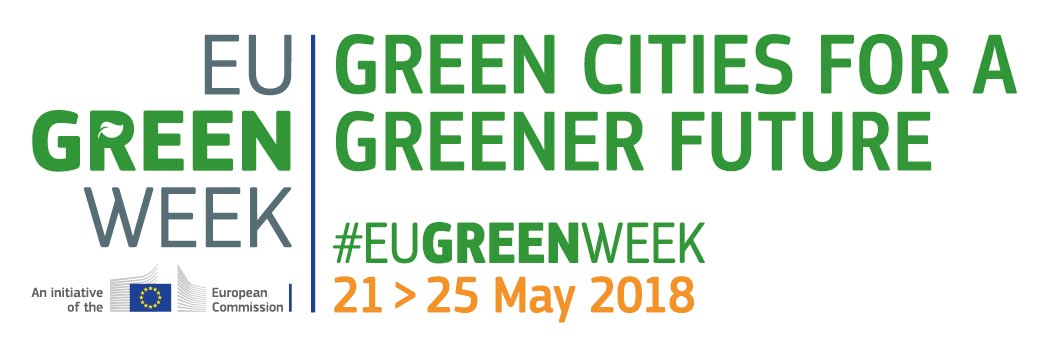
Showcasing policy developments on air quality, noise, nature & biodiversity, waste and water management, it will promote participatory approaches to urban development, networking schemes, and tools for sharing best practices, engaging local authorities and citizens, and encouraging them to share their vision of a sustainable future.
EUROPARC Webinar: Building Green Infrastructure around cities
From the protection of single Periurban parks towards the setting-up of a large green territorial system
EUROPARC will organise a special webinar to showcase how two different geographical realities – a compact city of 250,000 inhabitants and a diffuse metropolitan space of 3.2 M inhabitants – are implementing their green infrastructure, starting from the protection of single pieces of land and seeking to connect them, over time, to other spaces that have followed the same process.
Registration and all information here.
Other Events
In Brussels: Workshop Nature in the City
EUROPARC supported the organization of the workshop Nature in the City, that aims at showcasing how successful approaches protecting and restoring urban biodiversity bring benefits for people within and beyond city boundaries. See more information about the workshop here.
By EUROPARC members: “Amico Albero” & BioBlitz, Parco Nord Milano
“Amico Albero” aims to explore our connections with trees, which often tends to be considered as furnishing for urban areas. During this day Parco Nord Milano will host seminars, guided tours and workshops on different aspects about our relationship with trees. More information here. On May 20th, the Park will also organise an environmental education event “BioBlitz” focused on monitoring biodiversity in the Park. Read more about it here.
LIFE Project Awards
Vote for your favourite LIFE green city project! Pick your favourite green city project and meet its pioneers at EU Green Week 2018. The European Commission has shortlisted 6 finalists among 62 best LIFE projects. Votes will be collected until 25 April and winners will be revealed on the LIFE Award Ceremony on May 23.
Webinar: Periurban Parks – Building Green Infrastructure around Cities
On the occasion of the EU Green Week 2018 Green Cities for a Greener Future, EUROPARC is delivering a webinar on the role Periurban parks play in delivering ecosystem services and improving the livelihoods of citizens in and around cities. The webinar is an official event of the EU Green Week and the information can be seen here.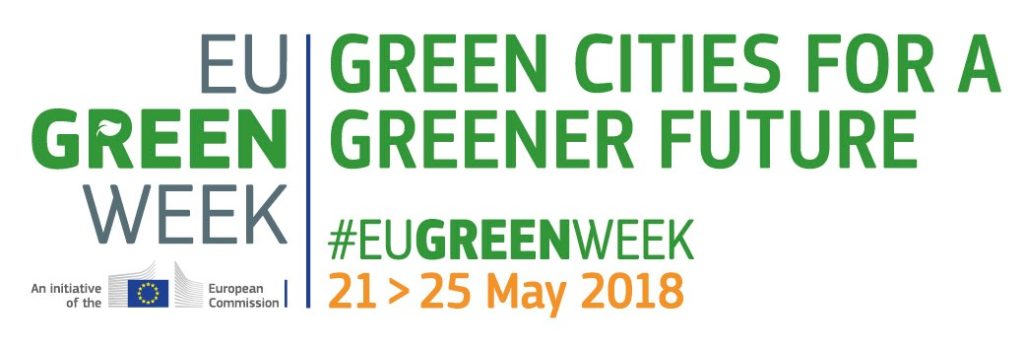
Building Green Infrastructure: from the protection of single Periurban parks towards the setting-up of a large green territorial system
- 15th May, 10:30 CEST (Central Europe Summer Time)
- Duration: 1:15hours
- Register here
The EU Green Infrastructure Strategy was launched in 2013 in order to help stop the loss of biodiversity and enable ecosystems to deliver their many services to people and nature. The green infrastructure basically consists of a strategically planned network of natural and semi-natural areas, with other environmental features, designed and managed to deliver a wide range of ecosystem services such as water purification, air quality, space for recreation and climate mitigation and adaptation. This network of green (land) and blue (water) spaces can improve environmental conditions and therefore citizens’ health and quality of life.
In the wider landscape, the EU green infrastructure is mainly constituted by the Natura 2000 network and the green corridors connecting these protected sites among them. However, in highly urbanised territories, the deployment of such green infrastructure is not an easy task. Urban sprawling and the presence of a large number of infrastructures difficult connectivity among the few open spaces left.
In the present webinar, we will showcase how two different geographical realities – a compact city of 250,000 inhabitants and a diffuse metropolitan space of 3.2 M inhabitants – are implementing their green infrastructure, starting from the protection of single pieces of land and seeking to connect them, over time, to other spaces that have followed the same process.
Case Study 1
The Green Belt: 25 years working for a multifunctional urban green infrastructure in Vitoria-Gasteiz
By Juan Carlos Escudero, Center for Environmental Studies of Vitoria-Gasteiz (CEA), Spain
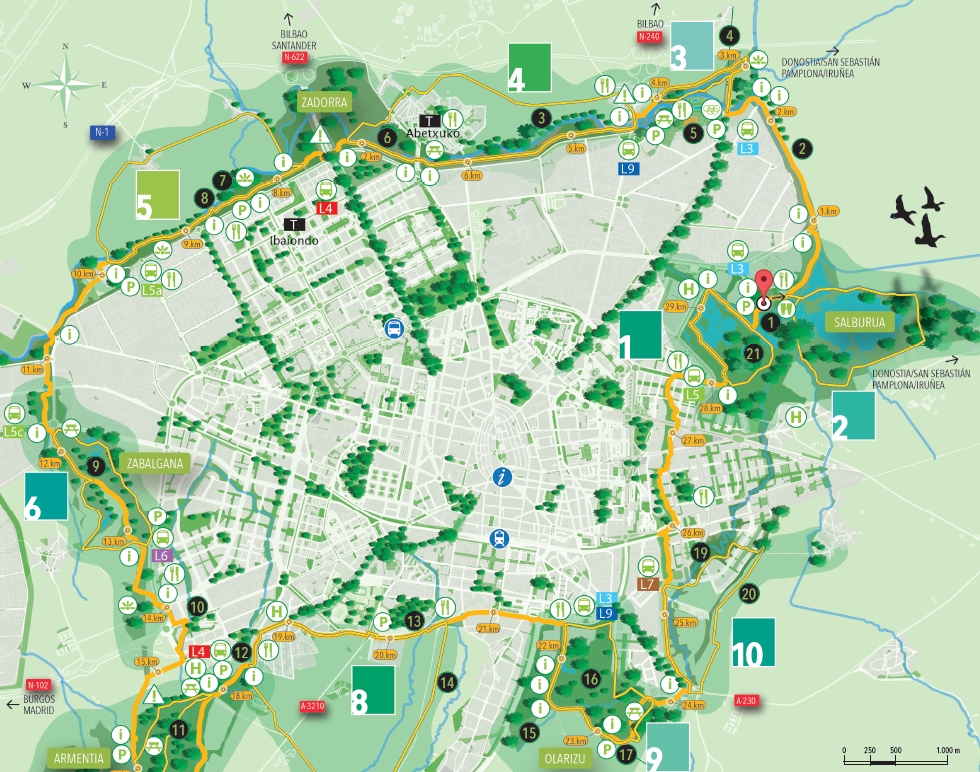
The Green Belt is the result of an ambitious project initiated in the early 1990s, the main of which was to restore and recover the outlying areas of Vitoria-Gasteiz, both from the environmental and social viewpoint, in order to create a large, green area for recreational use around the city.
After 25 years of work on the project, major efforts have been made to restore the ecology and landscapes of a number of degraded areas and to prepare these for public use. As the origin of the Urban Green Infrastructure of Vitoria-Gasteiz, the Green Belt is essential for the city to operate correctly. Besides its aesthetic and ornamental function and as well as being space for leisure pursuits and social relations, it plays a fundamental role in improving the environmental quality of the urban milieu, contributing to an improvement in the general habitability of the city and providing relevant ecosystem services to the city and its inhabitants.
Juan Carlos Escudero, Biologist, has been professionally linked to the Center for Environmental Studies of Vitoria-Gasteiz (CEA), an Autonomous Organisation of the City of Vitoria-Gasteiz. For more than two decades, Juan Carlos has been involved in different action lines in the fields of environmental information, research, innovation and development applied to the urban environment. Currently, he is also head of the Information and Innovation for Urban Sustainability Unit, where he promotes the management of information and innovation-oriented to new city and territory scenarios.
Case Study 2
Barcelona Green Metropolis, ecology, leisure and production
By Jacob Cirera Val and Teresa Gómez-Fabra Gala , Area Metropolitana de Barcelona
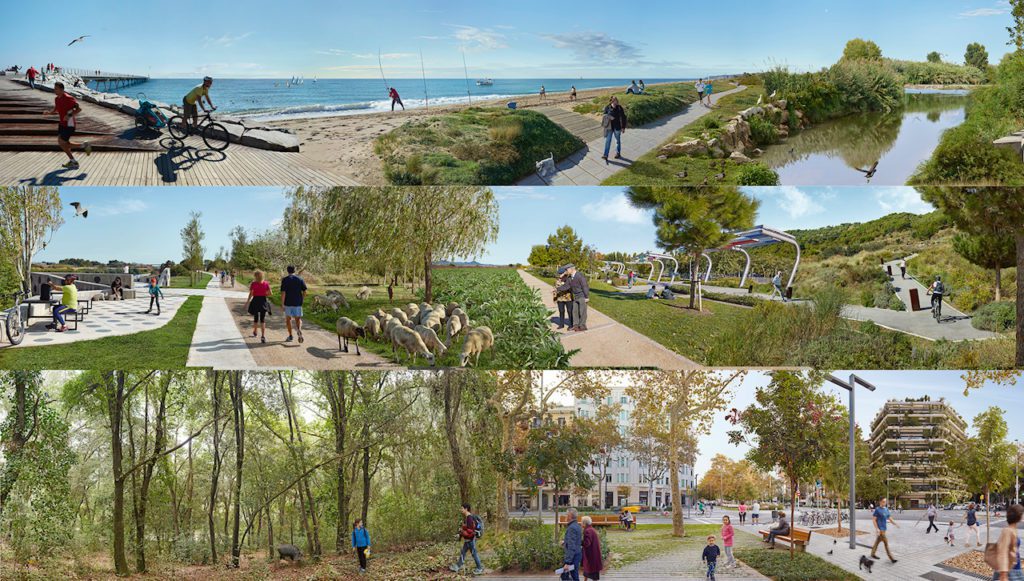
Barcelona Metropolis is characterised by being a compact and polycentric territory, which we call “metropolis of cities”. It is composed by a mosaic of urban and environmental spaces that co‐evolve and interact with each other. The territorial extension is over 636km2 and the population higher than 3.2 million citizens and 52% of the land is mainly occupied by green infrastructure.
This green infrastructure has a great environmental and social wealth value, and it is made up of more than 60 different habitats where more than 5,300 species live, divided into different types of areas: rivers (Llobregat and Besòs), natural Parks system (Collserola, Garraf and Serra de Marina), 32 km of metropolitan beaches, metropolitan Parks network, urban parks and other green spaces integrated in the city such as streets, squares, balconies or green rooftops.
A landscape formed by the coexistence of different ecosystems (environmental and urban) that create in their boundaries or edges, fringes, limits and spaces of transition with different characteristics that establish different relations between these two realities, the urban and the environmental one, so necessarily linked.
In order to reach our goals, we need to define a new metropolitan paradigm in relation with environmental, social and economic sustainability where the biodiversity and the maintenance of ecological processes should be guaranteed, by maximizing the ecosystem services and regulating the critical points. We will have a new network of open spaces interconnected and rich in ecological values, with different possibilities of use for the leisure time and with high productive capacities, an environmental and social network that will be the main structural metropolitan system of the metropolitan territory.
Jacob Cirera Val has a degree in Environmental Sciences from Girona University and Master’s degree in Application of Geographical Information Systems and Remote Sensing in Territorial Management from the Catalan Institute of Technology. He currently works in the office of the AMB’s Urban Master Plan and is a professor of “Environment and urban sustainability” as part of the City Management Master’s degree at the Open University of Catalonia.
Teresa Gómez-Fabra Gala has a degree in Architecture from Barcelona School of Polytechnic University of Catalonia (UPC) and a Postgraduate course’s degree in Local Agroecological Dynamization from Autonomous University of Barcelona (UAB). She currently works in the office of the AMB’s Urban Master Plan and is member of the “El Tinglado”, an architect collective.
How to join?
Webinars are open not only to EUROPARC members – but to everyone with an interest in Protected Areas. Participation is free but registration is necessary. You can join in from anywhere: you will just need a device with internet connection. Learn more about EUROPARC webinars.
Register here
Alpine Tundra of the Krkonoše and Tatra Mountains: Lessons for Ukraine
Alpine Tundra by Tymur Bedernichek
Every year, the Alfred Toepfer Natural Heritage Scholarship (ATS) supports the work of young conservationists in protected areas across Europe. Tymur Bedernichek is a Researcher at the M.M. Gryshko National Botanical Garden in Kyiv, Ukraine and was one of the winners of the Scholarship in 2016. Applications for the 2018 Natural Heritage Scholarship edition are open! Get to know how to apply.
Alpine Tundra of the Krkonoše and Tatra Mountains: Lessons for Ukraine
Issued by Tymur Bedernichek
The Alpine tundra or the third pole: here, above the alpine treeline, can still be found ecosystems and species that are very similar to those of the Arctic or the Antarctic. For example, there are more than 60 species of arctic-alpine plants in the Ukrainian Carpathians. They were widespread during the last glacial period and slowly retreated, following melting glaciers, to the north and up to the mountains.
These ‘pieces of Arctic’ remaining in the subalpine and alpine zones are extremely vulnerable to global warming. How can we save and research them? What are the primary threats to them? What is the best European practice in this field and can it be applied in Ukraine? I looked for the answers to these questions in the Krkonoše and Tatra Mountains.
Watch the short film that Tymur produced and download the full report of his study.
Why not the Alps?
Every second person learning that I was going to study how to protect and research alpine environments asked me this question. Why the Krkonoše and Tatra Mountains? Would it not be better to study alpine environments in the Alps? Probably yes, but not in the context that I am interested in.
The Soviet Union was too far away to affect the Alps, but it has had a significant impact on Poland and Czechoslovakia and, therefore, on the Tatras and the Sudetes. Hence, the experience of these countries is a matter of high importance for Ukraine. Moreover, before 1939, the part of the Eastern Carpathians that today belongs to Ukraine was divided between Poland and Czechoslovakia. This makes the historical context of the study visit even stronger.
Before 1939, the Eastern Carpathians blossomed. It was the place where top-quality Emmental cheese was produced and from where it was supplied to Prague and Vienna. Travelling from Pop Ivan (Maramureș) to Pop Ivan (Chornohora) was a popular way to spend a honeymoon. Roads and bridges were built, nature reserves were founded, numerous shelters and small hotels were opened for tourists from all over Europe. All of this came to an end with the World War II. During the Soviet occupation, all borders were closed and most hotels and shelters in the mountains were burnt down. For many decades, this territory disappeared from the European cultural area.
However, some popular local surnames of Western origin, such as Fabricius, Burger, Ginsburg, Langer, Kabal, Coradini, Manfredi and many others, clearly indicate the multicultural nature of the region. Various cultures significantly affected both the population of the mountains and the mountains themselves.
If I were asked to name one culture that has determined the ways of life in the Carpathians for hundreds of years, I would say, it’s Wallachian shepherds.
Shepherds and sheep
Livestock and sheep in particular have left a strong imprint on the subalpine and alpine zones of all the European mountains. It has been reported that the first evidence of sheep farming in Europe goes back to 6,000 years BC. Several such sites have been found in the Southern Alps. Later, about 4,000–3,000 years BC, there was already a large number of sites in the European mountains showing signs of pastoral farming. During that time, sheep began to play an important role globally.
Later, in 77–79 AD, Gaius Plinius Secundus wrote: “Many thanks, too, do we owe to the sheep, both for appeasing the gods and for giving us the use of its fleece.” However, it seems that until the Middle Ages, when the sheep population in Europe drastically increased, there was enough space for everyone.
From the 13th through the end of the 16th century, Wallachian shepherds wondered from the Danube through the entire Carpathians. Obviously, they chose subalpine and alpine grasslands as fertile pastures for their livestock. However, Wallachian shepherds had too many sheep and needed still more pastures to feed them. To this end, they significantly enlarged the grasslands territory by cutting down krummholz and high-mountain forests.
Other ethnic groups residing on this territory much longer, such as Hutsuls, Lemkos, Boykos, Gorals and many others, were strongly influenced by the Wallachian shepherds. They had similar clothes, music, and traditional food, and, similar to Wallachs, they began to enlarge the territory of the mountain pastures for their sheep.
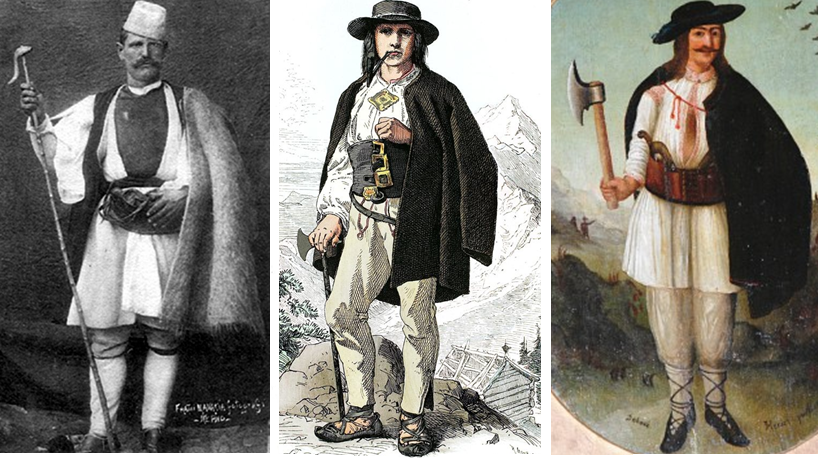
Wallachian shepherd, Polish goral and Ukrainian hutsul in traditional clothes (from left to right), late 18th – early 19th century
Just several hundred years of such activities drastically lowered the alpine tree line, and artificial grasslands spread to large territories. Even today, the alpine tree line is 120–150 lower than it was before the Wallachian expansion. Hence, the krummholz, especially broadleaf, has almost disappeared from the Carpathians. It can still be found only in the most remote areas, far away from major roads and towns.
Intensive grazing in high-mountain pastures was popular until the 1950s. Until that time, alpine treeline continued to decrease: the numbers of sheep kept growing, and cheese production required a lot of firewood, which was harvested locally. Intensive grazing and overstocking also directly affected the plants and soils of the subalpine and alpine zones. Such conditions were favorable for some species and devastating for others.
Today there are far less sheep in the mountains. For example, there were more than 10,000 sheep on Pop Ivan Maramureș in the 1930s, whereas now there are less than 500 left. In many places, sheep and shepherds disappeared altogether, while in some places they are just kept as decorations. For example, in Tatra National Park, I tasted several traditional ‘sheep milk cheese.’ Though tasty enough, they were unfortunately made of cow milk.
Mountains calling!
Tourism in general and mountain tourism in particular are rather new phenomena. Before the 18th century, there were very few people who would go hiking just for fun, especially in the context of the prevailing belief that only poor men and vagrants could walk long distances.
However, Romanticism brought about new ideas and changed the attitude to Nature. More and more people were choosing mountains for recreation: some of them to see new places, faces, and countries, while others just to leave cities with their unsanitary conditions and diseases.
In the early 19th century, numerous tourist clubs and societies sprang up all over the world. They published newspapers and magazines dedicated to hiking, sailing and camping, and these activities were becoming more and more popular. Finally, a new genre emerged, known as outdoor literature. Such books as Walden by Henry David Thoreau (1854) or Travels with a Donkey in the Cévennes (1879) by Robert Louis Stevenson became classic and had a huge impact on other authors and the outdoor literature in general. Naturally, a lot of outdoor classics were written about the mountains, for example, Scrambles Amongst the Alps in the Years 1860-1869 by Edward Whymper (1871) or Mountaineering and Exploration in the Japanese Alps by Walter Weston (1896).
Mountains of Central and Eastern Europe did not go unnoticed either, and in 1892 A Girl in the Karpathians by Scottish writer Menie Muriel Dowie was published. She told about her travel from Transylvania through almost all the Carpathians to Poland. There are many more examples of such literature that resulted in the increased popularity of the European mountains in general and the Carpathians in particular.
The dissolution of the Austro-Hungarian Empire ushered the beginning of a tourism boom in Poland and Czechoslovakia. The necessary infrastructure was built: roads, hotels, and tourist shelters. For example, in the 1930s, there was a popular hotel with 70 beds on Pop Ivan Maramureș (see below), which looked similar to those that can still be found in the Krkonoše and the Western Carpathians. However, most of such shelters and hotels in the Eastern Carpathians and, in particular, the Ukrainian Carpathians were destroyed during the Soviet period. The one on Pop Ivan that is shown in the photo was ‘accidentally’ burnt in the 1960s.
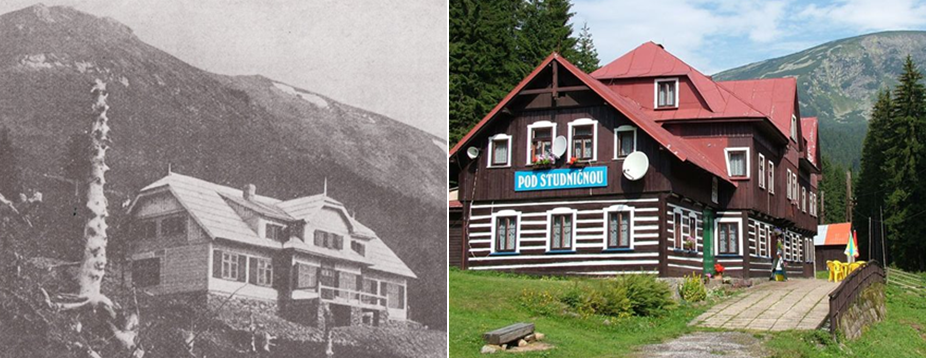
Tourist shelters in the Carpathians (left) and the Krkonoše (right), credit to http://www.podstudnicnou.cz
Only in the last 10–15 years, the infrastructure was slowly being rebuilt. Unfortunately, too slowly to accommodate all tourists, which is why wild tourism is so widespread and so popular here.
Wild, wild East
After the dissolution of Soviet Union, the Ukrainian Carpathians (part of the Eastern Carpathians) became for a while a kind of a no man’s land. Army and border guard lost their power, while the newly elected government had no authority there. During that time, known as the “tumultuous 1990s,” the Ukrainian Carpathians were very much the same as the Wild West of the USA in the 19th century. The most significant difference was that here nobody would shoot pianists in saloons.
Those times of freedom-for-all led to numerous crimes, both against people and against nature. Mass and uncontrolled clear felling, mass and uncontrolled tourism and poaching were typical during that time. Obviously, there were no limitations on off-roading there. Hundreds of people were mostly using military and demilitarized vehicles: light utility cars like UAZ-469 or LuAZ-967, or even various armored personnel carriers — you could find almost any car back then!
The catastrophic floods of 1998 and 2001 reduced the enthusiasm of foresters and wood-thieves, but overindulgence remained. Even today, hundreds of off-roaders, not only from Ukraine, but from all over Europe come to the Ukrainian Carpathians to have fun. Usually, it does not matter whether you are driving through a primeval forest or alpine grassland. Nobody cares, or do they?
In Poland and Czechoslovakia, things were much better. Those countries were under the Soviet umbrella but had never been a part of the Soviet Union, and during that period they managed to keep and protect the most important collections in the museums, galleries, and herbariums, as well as the infrastructure. Probably the very best example of the two different worlds that existed in the former Soviet republics (and partly in today’s Ukraine) and non-Soviet states of Eastern Europe are two meteorological observatories in the mountains, built almost at the same time.
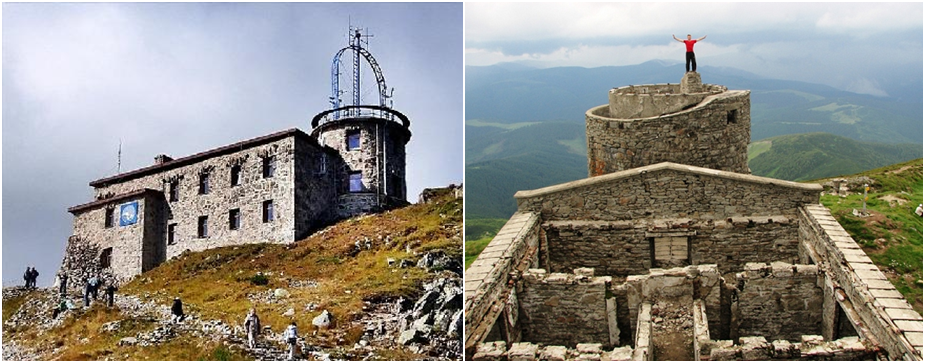
Observatory on Kasprowy Wierch (left) and the ruins of the observatory on Pop Ivan (right). Both were built in the 1930s.
The first one is located on Kasprowy Wierch (Tatra National Park, Poland) and has been operating since 1937. The second one is on Pop Ivan (Carpathian Biosphere Reserve, Ukraine). It was destroyed in 1941 and has never been rebuilt. There were several attempts to rebuild the observatory on Pop Ivan and much more discussions about it.
Finally, the agreement between Ukrainian and Polish presidents was made, and owing to the joint efforts of the University of Warsaw and the Vasyl Stefanyk Precarpathian National University, the reconstruction has finally begun. It is rather slow, but hopefully, the new Polish-Ukrainian center for young scholars will open there soon. For me, this collaboration is very symbolic, and the reconstruction itself means much more than just rebuilding a site: it means the reintegration of this territory into Europe.
Ukrainian teporingo
In 1972, Gerald Durrell published his famous book, Catch Me a Colobus. I would like to quote here a short extract about Durrell’s expedition to South America, where he looked for one of the most vulnerable species in Mexico, volcanic rabbit or teporingo:
‘Where’, I inquired, ‘are they?’
‘Oh,’ he said, ‘I ate them.’
This is an animal which, on paper at least, is one of the most strictly protected creatures in Mexico, and this was a forest guard, inside a national park, speaking to me. This sort of thing is not just common to Mexico, it is common all over the world where animals receive what I call ‘paper protection’ but are not protected in fact.
Paper protection! Unfortunately, this is how it still works in Ukraine. Too often protected areas are not protected in fact.
Likewise, rare and threatened species may well be included in regional and national red lists, but not conserved in situ.
There is some evidence that the situation has slightly improved by now, but it is still too early to state that park rangers and forest guards do not shoot ‘Ukrainian teporingos.’ In fact, they do. Recently, in autumn 2017, park rangers in the Ukrainian Carpathians shot the brown bear, Eurasian lynx, and black grouse. All of these species are listed in the Red Book of Ukraine. Killing these animals is a felony in Ukraine. However, as you probably guessed, no one was punished for that. For example, Vasyl Kabal (below) explained that he was just walking around with his rifle and his dog and found animals that had already been killed. For sure, he decided to take a photo. These explanations were accepted as reasonable and sufficient. As for me, this is the best way to encourage poachers.
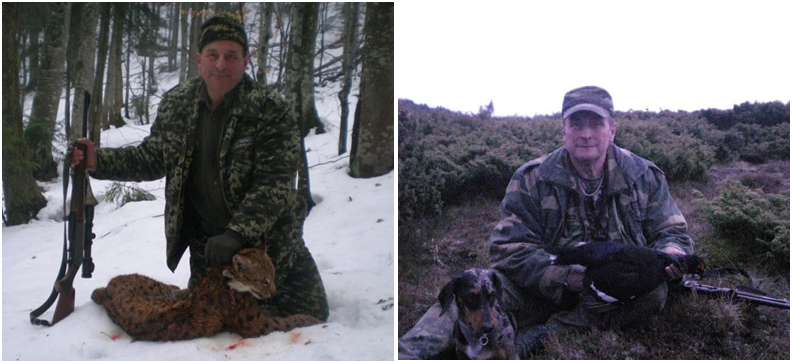
Forest guard Vasyl Kabal shot a Eurasian lynx and a black grouse
In Tatra National Park, I had a discussion with a colleague. At first, he told me about an awkward situation when a man, who, not knowing that this was forbidden, swam in a glacial lake in the Tatra Mountains. We both laughed at him. How could possibly an adult person behave in such a way? Is it not obvious that unique and fragile ecosystems of glacial lakes must be protected as much as possible?
That same evening, my colleague told me over a cup of coffee that the lakes we had seen that day were probably full of leeches, since there are lots of them in the Ukrainian mountain lakes. He said that there were so many of them that each time he swims in mountain lakes in the Ukrainian Carpathians he covers his whole body with shower gel to stop them from biting him.
Obviously, I asked him how his behavior corresponds to mocking a man who swam in a mountain lake in Tatras. The answer stunned me. ‘It is allowed in your mountains. At first, I did not do that, but then I saw hundreds of people swimming in glacial lakes and no one stopped or punished them. Then I saw park rangers who drove right up to the lake, swam there and washed their boots. So why should I avoid doing that?’ Certainly, I had nothing to say. He was right. You cannot demand somebody to respect your home if you do not take care of it at all.
However, it has to be said that a park ranger in Ukraine is not the most prestigious and profitable profession. Usually, they are paid less than 130 EUR per month, which is not enough even to buy food. Often, park rangers have no necessary equipment, even the basic one. For example in winter, poachers often use snowmobiles, whereas park rangers do not even have snowshoes or skis!
Some of them are real nature conservationists and try to earn money, for example, by selling mushrooms, and to buy their own equipment, to be more effective as a park ranger. Most of them, however, are not. There is a popular saying in Ukraine: ‘They pretend to pay us, and we pretend to do the job.’ It accurately reflects the situation with nature conservation. Therefore, such rangers often go hunting, not just to have fun, but to get food for their families. Often, even when they notice a poacher, or illegal logging, or other forbidden activities, they choose not to interfere: there are not so many heroes to risk their lives for a symbolic salary. Obviously, neither in Poland nor in the Czech Republic such behavior would be impossible. Yes, poachers are everywhere and the European Union is no exception, but the scale of the problem is different, very different.
Unobvious threats: ski resorts
Before my study visit to the Krkonoše and the Tatra Mountains, I knew very little about ski resorts as an environmental problem, especially for fragile subalpine and alpine ecosystems. However, those threats are well known, and they become more and more important due to climate warming. Lewis Milford, an environmental lawyer, wrote in 1994:
‘When it comes to environmental damage, we tend to think of the traditional bad guys — mining, logging, ranching. But snowmaking takes a lot of water out of rivers and streams, in some cases depleting them to dangerously low levels.’
In July 2017, when I was reading these words in Výrovka tourist shelter in the Krkonoše, I had no idea how important for me and my friends they would become in the immediate future, or how important would be the experience of the Krkonoše National Park and partly of the Tatra National Park for us to develop a strategy to conserve the Svydovets mountain range (Ukrainian Carpathians), where the Carpathians’ largest ski resort was to be built.
Then, in the Krkonoše, I was wondering just how vulnerable and fragile the alpine tundra could be and how significantly such unobvious factor as artificial snow production could affect this environment. When it comes to large-scale impacts, such as changes to water levels in rivers and streams and to the microclimate of the territory, in general, they affect the entire territory, whether protected or not. In such circumstances, it is really difficult and sometimes even impossible to conserve species and habitats even in national parks and nature reserves.
In autumn 2017, we heard about the plans of Ukrainian oligarchs (who already own ski resort Bukovel in Ukraine and Semmering in Austria) to build a huge ski resort Svydovets in one of the wildest parts of the Ukrainian Carpathians, which is home to more than 100 threatened plants and animals. The resort is designed to have 28,000 tourists and 5,000 staff. The infrastructure is planned to cover over 1,400 ha, including hotels, banks, molls, and even a landing field. If built, Svydovets would be twice the size of Rakhiv, the administrative center of the Rakhiv district where the ski resort is planned to be built.
Opposing multi-billionaires is not an easy task in any country, especially in Ukraine. However, local people, nature conservationists, activists, and scientists joined their efforts and created an initiative group Free Svydovets that managed to win a court case and suspend the construction. But that was only one battle, and the war is going on. This is why we really do need the support of international environmental organizations and, in particular, of EUROPARC Federation to protect Svydovets, a unique site which is an island of biodiversity.
Ski resorts are moving higher and higher, looking for snow and escaping from global warming. This problem is also global and affects countries from Argentina to Azerbaijan (and this is only the letter A). Hence, nature conservationists must be prepared for these threats. As for me, I would prefer to look for answers in the Krkonoše National Park.
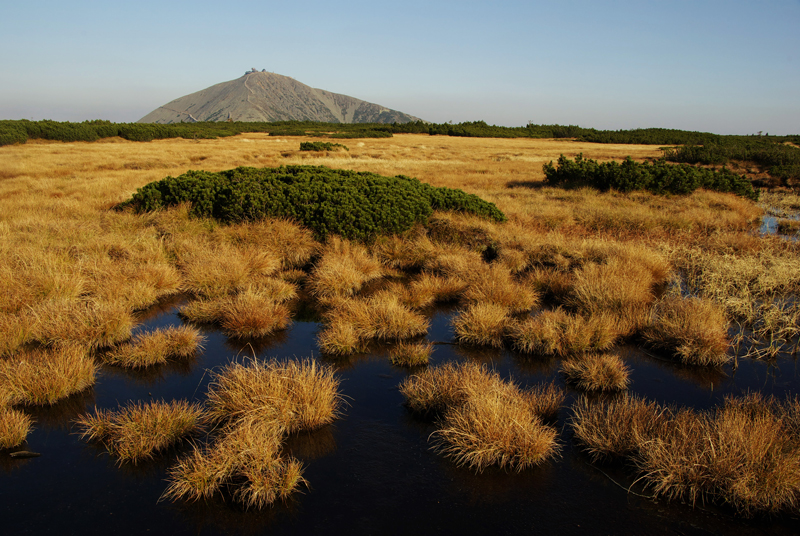
Krkonose National Park, Czech Republic © Kamila Antošová
They faced the same problems, and their solution, to my mind, should be taken into consideration. The national park managed to do almost the impossible after the ecological disaster in the Krkonoše, and it is the best national park I have seen in my life, and I saw many of them in Europe, Asia, and Africa. Therefore, the experience and advice of the Czech colleagues seem very important for Free Svydovets initiative group, and we hope to see them either in the Carpathians or in the Krkonoše soon.
INTERACT and GLORIA: perspectives for Ukraine
When I was preparing for my study visit, I hoped to find an answer to the question: ‘Why neither GLORIA nor INTERACT have their stations or monitoring plots in Ukraine?’. GLORIA (Global Observation Research Initiative in Alpine Environments) project has a network of monitoring plots on six continents, and INTERACT (International Network for Terrestrial Research and Monitoring in the Arctic) on three continents, but not in Ukraine. Why? Especially taking into account that different studies have been carried out in the subalpine and alpine zones of the Ukrainian Carpathians for a long period of time. For example, “Pozhyzhevska” research station was founded 60 years ago.
At first, I thought that Ukrainian Carpathians are not high enough for these projects, but they are. For example, there are only 4 peaks higher than 1,500 m a.s.l. in the Krkonoše and 6 peaks higher than 2,000 m a.s.l. in the Ukrainian Carpathians. So, there must be a different reason.
I realized the real reason only when I was in the Krkonoše. GLORIA means infrastructure and a lot of work: hundreds of hours for 3-4 scientists to study all the plots, while the initiative itself is designed for a long-term perspective. INTERACT also means infrastructure and a lot of work, and is focused on long-term studies and effects. However, research infrastructure is necessary only to conduct top-level research and to publish results in top-level journals. But Ukrainian scientists are not motivated to publish their results in such journals: there are no funds to cover publishing fees, the level of the journal has no effect on the status of a researcher in Ukraine, and such publication is not required for national research projects.
What really does matter here is the number of articles published, no matter in what journals and in what language. Obviously, if there is no difference, it is much easier and cheaper to write in Ukrainian journals, which are often even not peer-reviewed. This situation is not something new. Poland and the Czech Republic, as well as the other countries of Central and Eastern Europe, faced the same problems and solved them successfully. For example, salaries of Czech researchers directly depend on the quality of their papers and the impact factor of the journals. Such logical and even obvious measure quickly increased the number of high-quality articles published in top-level journals by Czech scientists in the early 2000s, and it keeps growing.
As for our prospects of participating in GLORIA and INTERACT, this May, together with my colleagues, we will begin the approbation of the GLORIA protocol on Svydovets mountain range. Before the end of 2018, we will apply for participation in INTERACT with Deyl Alpine Research Station that will be located on Pop Ivan Maramureș.
Ukrainian national parks are European. NOT
There are huge differences between protected areas within and without the European Union, and even between the member states. Below I wanted to show only the differences that are most important to me as a scientist that significantly affect management, nature conservation, and research. These are, first of all, the social and economic aspects that may determine the efficiency of a national park in general.
Important differences between PAs in Ukraine, Poland and Czech Republic
| Ukraine | Czech Republic | Poland | |
| access to PAs for visitors | paid admission1 | free | paid admission |
| average staff salary | lower than a living wage | competitive | competitive |
| research | conducted2 | coordinated | coordinated |
| monitoring | conducted | conducted | conducted |
| nature conservation | national level | national level+EU3 | national level+EU3 |
| environmental fines | low | high | high |
| leaving pathways | allowed | forbidden | forbidden |
| making fire | allowed | forbidden | forbidden |
| camping | everywhere | only campsites | only campsites |
| tourist shelters | free | for a fee | for a fee |
| off-roading | formally forbidden4 | forbidden | forbidden |
| role of PAs in environmental education | low | high | average |
| role of PAs in ex-situ and in situ conservation | low | high | average |
| impact on adjacent territories | low | high | high |
1 Visitors should have tickets to enter Ukrainian PAs. Unfortunately, these are not available online as in Poland and there are no fines for access without a ticket. Therefore, most tourists do not buy them
2 Ukrainian protected areas usually have their own research departments. Scientists from these departments are responsible for conducting research independently, but not for coordinating research on the territory of a PA in general
3 Habitats and species in Poland and the Czech Republic are protected both by national and international laws. For example, there might be NATURA2000 sites on the territory of PAs, giving them additional protection
4 In Ukraine, off-roading on the territory of PAs is only formally forbidden. The son of our former president Yanukovych used to organize and participate in numerous off-road competitions in PAs, including strict nature reserves
There are huge differences between Ukrainian (post-soviet) and European approaches to nature conservation.
They are partly reflected in the table above. Much more details could be found in the report. However, these differences are less important than the fact that sooner or later, Ukrainian national parks will become European national parks. This process is unavoidable since it is driven by the social, economic and geopolitical necessity to expand into Eastern Europe. And it does not matter how soon: in 5, 10, or 20 years. What really matters is the state of the Ukrainian protected areas when Ukraine enters the EU. I believe that this issue should be important not only to Ukrainian but also to European nature conservationists.
The study visit to the national parks in the Krkonoše and the Tatra Mountains, which was supported by EUROPARC Federation and Alfred Toepfer Foundation, was a kind of a time machine for me. I saw what Ukrainian national parks in the Ukrainian Carpathians will look like or, better to say, would look like in 25 years. Unfortunately, the climate is changing, and we do not have too much time, and neither do the especially fragile subalpine and alpine ecosystems. Hence, the best European practices in nature conservation and the support of international environmental organizations, like EUROPARC Federation, are vitally important to us. They would help us save and conserve much more.
Since you are reading this, could you please support our campaign for conservation of the Svydovets Mountains (Ukrainian Carpathians) and sign the petition on our website freesvydovets.org?
